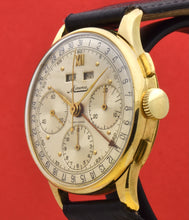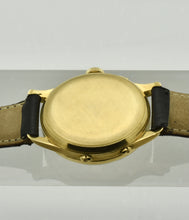
Minerva, triple calendar chronograph, made circa 1955.
Fine, manual-winding, 18 karat yellow gold wristwatch with square button chronograph, registers, and triple date.
Case: 18 karat Gold, three-body, polished and brushed, concave lugs, inclined bezel, snap-on case back, signed Minerva.
Dial: Brushed silver with applied Roman numeral at 12 and gold markers, outer minutes and 1/5th seconds track, subsidiary dials for the seconds, the 12-hour and 30-minute registers, apertures for the days of the week and months in French. Thin hands. Signed Minerva.
Movement: Valjoux 72, gilt brass, 17 jewels, straight-line lever escapement, monometallic balance with screws, blued steel over-coiled balance spring, index regulator, signed Minerva.
Diameter : 36mm, Thickness: 11.5mm
Minerva Watches began their history in 1858 in Villeret, Switzerland when it was founded by the Robert family. The company name changed several times, becoming Fabrique Robert Frères in 1898, then Fabrique des Faverges in 1902, Fabrique Minerva in 1923 and eventually in 1929 it became Minerva SA.
In 1902 Minerva became a "manufacture" of watches designing and manufacturing the most critical watch parts, such as the movement, in their own engineering workshops. The earliest Minerva wristwatch was manufactured in 1909, but Minerva's greatest success came in 1923 with the introduction the No. 20, a caliber which was a chronograph with a column-wheel mechanism, a Breguet balance-spring and 17 jewels. With the launch of this watch, the company earned its reputation as a manufacturer of complicated movements of exceptional quality.
Minerva, up until 2000 when it was purchased by an Italian company who later was sold to the Richemont Group with Minerva SA movement production being integrated to Montblanc. Minerva was one of very few companies to produce their own movements, especially the chronograph and one of even fewer who had done so continuously for close to a hundred years.























